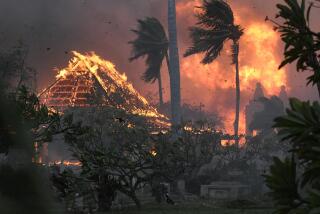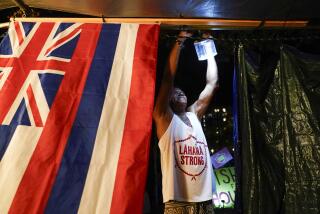Digest this
- Share via
Question: My spouse and I are planning a trip to Maui. We have heard that food prices in markets and restaurants have soared recently in Hawaii because of the increased costs of fuel. What can we expect to pay?
R. Grimaldi
Los Angeles
Answer: A small fortune.
Hawaii’s food prices have always been higher because of shipping costs, and with gas prices in the stratosphere -- well, owie, Maui.
Or, put more eloquently, listen to what Lynn Nakamura-Tengan, an extension educator for the University of Hawaii, said in an e-mail to me: “Maui does have the highest fuel prices in the state. Shippers are adding fuel surcharges, which adds to costs of all items. Even . . . locally produced foods are affected by fuel prices since farmers and wholesalers are paying fuel surcharges on items such as boxes, fertilizers or produce being shipped inter-island.”
Even before the fuel run-up, U.S. Department of Agriculture figures for the second half of 2007 showed that in Hawaii it cost about $300 a month more to feed a family of four a very modest diet than it did a family on the mainland.
That hits families like the Garsos of Lahaina hard. Lahela Garso and husband Keoni have two girls, 6 and 6 months, and are taking care of two nephews. She does a jumbo shopping trip about every six weeks at a big-box store. “Our last bill was $550. Before that, we’d never gone past $400. I couldn’t believe it. I’m like, ‘Are you sure?’ It’s like paying rent! Just for food!”
So how bad is it? A quick scan of last week’s grocery specials for Safeway in Lahaina versus a Vons in Glendale bears out the pain. At the Maui store, shoppers paid $10 for 2 gallons of milk; in Glendale, shoppers paid $6.19 for 2 gallons. In Lahaina, a loaf of butter-top bread was $3.49; in Glendale, you could get three loaves of bread for $5. These aren’t precisely mangoes to mangoes, but you get the idea.
In its May survey of the most and least expensive places to vacation, AAA rated Hawaii as the top o’ the money heap, estimating that a couple would spend about $118 a day on meals. (To see a list of inexpensive but delicious dining options, go to latimes.com/mauifood.) Stack that up against North Dakota, the least expensive place to visit, which came out to $63 for two for daily grub.
To keep costs down, look for hotel deals that come with breakfast or consider a condo where you can make your meals. Take your grocery or box-store club card (at the Oahu rental house where I stayed in May, the owner thoughtfully provided several); shop the local farmers market; eat as the locals eat (plate lunch, anyone?). Paradise comes at a price, but in Hawaii’s case, I’ll pay it every time.
--
Have a travel dilemma? Write to [email protected].
More to Read
Sign up for The Wild
We’ll help you find the best places to hike, bike and run, as well as the perfect silent spots for meditation and yoga.
You may occasionally receive promotional content from the Los Angeles Times.







